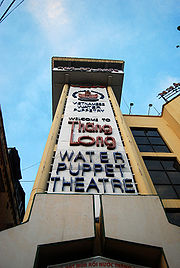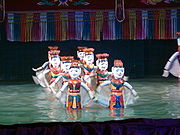
Roi nuoc
Encyclopedia

Red River Delta
The Red River Delta is the flat plain formed by the Red River and its distributaries joining in the Thai Binh River in northern Vietnam. The delta measuring some 15,000 square km is well protected by a network of dikes. It is an agriculturally rich area and densely populated...
area of northern Vietnam
Vietnam
Vietnam – sometimes spelled Viet Nam , officially the Socialist Republic of Vietnam – is the easternmost country on the Indochina Peninsula in Southeast Asia. It is bordered by China to the north, Laos to the northwest, Cambodia to the southwest, and the South China Sea –...
. Today's Vietnamese water puppetry is a unique variation on the ancient Asian puppet tradition.
The puppets are made out of wood and then lacquer
Lacquer
In a general sense, lacquer is a somewhat imprecise term for a clear or coloured varnish that dries by solvent evaporation and often a curing process as well that produces a hard, durable finish, in any sheen level from ultra matte to high gloss and that can be further polished as required...
ed. The shows are performed in a waist-deep pool. A large rod supports the puppet under the water and is used by the puppeteers, who are normally hidden behind a screen, to control them. Thus the puppets appear to be moving over the water. When the rice fields would flood, the villagers would entertain each other using this form of puppet play.
History

Dong Hung
Dong Hung is a district of Thai Binh Province in the Red River Delta region of Vietnam.Ðong Hung is the homeland of hát chèo, a traditional Vietnamese music genre and water puppet. The district is also well known for Cay cake....
district, Thai Binh province
Thai Binh Province
Thái Bình is a coastal eastern province in the Red River Delta region of northern Vietnam, named after the Vietnamese name for the Pacific Ocean: Thái Bình Dương...
.
In ancient Vietnam, the rural Vietnamese believed that spirits controlled all aspect of their lives, from the kitchen to the rice paddies. The Vietnamese devised water puppetry as a way to satisfy these spirits, and as a form of entertainment, using what natural medium they could find in their environment. In ancient times, the ponds and flooded rice paddies after harvest were the stage for these impromptu shows.
This art form is unique to North Vietnam and only found its way to the world stage in recent years as a result of normalized relations with the West. During the early 1990s the country's three foremost companies, the National Puppet Theatre (Nhà hát Múa rối Trung Ương), the municipal Thăng Long Puppet Company (Nhà hát Múa rối Thăng Long) of Hanoi and the Hồ Chí Minh City Puppet Company (Đoàn Nghệ thuật Múa rối Thành Phố Hố Chí Minh) gained increased international attention. The main venues in Vietnam itself are the Thăng Long Water Puppet Theatre in Hanoi
Hanoi
Hanoi , is the capital of Vietnam and the country's second largest city. Its population in 2009 was estimated at 2.6 million for urban districts, 6.5 million for the metropolitan jurisdiction. From 1010 until 1802, it was the most important political centre of Vietnam...
and the Golden Dragon Water Puppet Theatre in Saigon.
Performance
.jpg)


Up to 8 puppeteers stand behind a split-bamboo screen, decorated to resemble a temple facade, and control the puppets using long bamboo rods and string mechanism hidden beneath the water surface. The puppets are carved out of wood and often weigh up to 15 kg.
A traditional Vietnamese orchestra provides background music accompaniment. The instrumentation includes vocals, drums, wooden bells, cymbals, horns, Đàn bầu (monochord), gong
Gong
A gong is an East and South East Asian musical percussion instrument that takes the form of a flat metal disc which is hit with a mallet....
s, and bamboo flutes. The bamboo flute's clear, simple notes may accompany royalty while the drums and cymbals may loudly announce a fire-breathing dragon's entrance.
Singers of chèo
Chèo
Chèo is a form of generally satirical musical theatre, often encompassing dance, traditionally performed by Vietnamese peasants in northern Vietnam...
(a form of opera originating in north Vietnam) sing songs which tell the story being acted out by the puppets. The musicians and the puppets interact during performance; the musicians may yell a word of warning to a puppet in danger or a word of encouragement to a puppet in need.
The puppets enter from either side of the stage, or emerge from the murky depths of the water.
Spotlights and colorful flags adorn the stage and create a festive atmosphere.
Content
The theme of the skits is rural and has a strong reference to Vietnamese folklore. It tells of day-to-day living in rural Vietnam and Vietnamese folk tales that are told by grandparents to their grandchildren. Stories of the harvest, of fishing and of festivals are highlighted.Legends and national history are also told through short skits. Many of the skits, especially those involving the tales of day-to-day living, often have a humorous twist.
External links
- Thang Long Water Puppet Theatre Homepage
- Golden Dragon Water Puppet Theatre Homepage
- Vietnamese water puppet show with video

